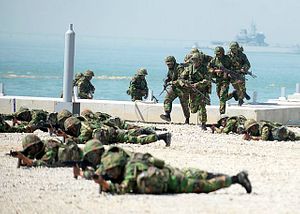The success of the Incheon landing of September 15, 1950, had long-term consequences for U.S. foreign policy in Asia and the rest of the world. Incheon and its aftermath represented the first real-world test of whether containment, as advocated by George F. Kennan, or liberation, as advocated by James Burnham, would be the guiding postwar doctrine of American foreign policy.
Ever since Kennan wrote his famous “X” article in Foreign Affairs in July 1947, in which he advocated “firm and vigilant containment” of Soviet expansionist tendencies, and James Burnham responded in a trilogy of books – The Struggle for the World, The Coming Defeat of Communism, and Containment or Liberation? – that containment was not enough, that we needed to liberate territories and people under Soviet control, Americans and American policymakers debated the best approach to the Soviet threat. Incheon and its aftermath changed that debate from an academic exercise to an actual policy choice.
The Truman administration’s initial policy choice was for liberation. General Douglas MacArthur’s battlefield success sent North Korean troops reeling across the 38th Parallel, and both the Truman administration and the United Nations authorized MacArthur to send forces into North Korea with the goal of liberating the country from communist rule. This remained the policy choice until Chinese troops crossed the Yalu River and entered the war in full force on North Korea’s side. Unwilling to wage a wider war against China, and despite protests from MacArthur, the Truman administration’s policy slowly evolved toward settling for containment on the Korean peninsula.
The Korean armistice set a policy precedent, but it did not settle the larger academic policy debate. In the election of 1952, GOP candidate Dwight Eisenhower and the GOP platform called for rolling-back the Soviet empire, i.e., liberation. Eisenhower’s top foreign policy advisor and future Secretary of State John Foster Dulles wrote an article in Life magazine extolling the virtues of rolling-back the Soviet empire. In Korea, Eisenhower maintained Truman’s policy of containment. When faced with opportunities to implement rollback in East Germany in 1953, Poland and Hungary in 1956, Eisenhower, like Truman, drew back from liberation and settled for containment. The Korean precedent – the consequence of Inchon and its aftermath – was followed.
The next policy test came in Southeast Asia. After the North Vietnamese infiltration of, and aggression in, South Vietnam, Presidents Kennedy, Johnson and Nixon fought that war largely inside the territory of South Vietnam, adhering to the Korean precedent of containment. Indeed, when the United States lost the war in Southeast Asia, James Burnham blamed its defeat on the “self-imposed strategic prison” of containment.
When a democratic political uprising in Czechoslovakia was crushed by Soviet military forces in 1968, the Johnson administration did not interfere, hewing to the Eisenhower precedent consistent with the overall policy of containment, and consistent with the Brezhnev Doctrine which proclaimed the right of the Soviet Union to use military force to maintain communist regimes in power.
The Korean precedent and Eisenhower precedents remained inviolate in U.S. foreign policy until the Reagan administration. President Ronald Reagan signed national security directives establishing the downfall of the Soviet Union as a policy goal. He significantly increased military aid to the Afghan Rebels who challenged Soviet rule. He supported the rebels in Nicaragua who challenged the rule of the Marxist Sandinista regime. He liberated the tiny Caribbean island of Grenada from communist rule. He conducted economic and political warfare against the Soviet Union. Reagan’s policies, combined with Soviet vulnerabilities and Gorbachev’s unwillingness to crush rebellions in Eastern Europe, led to the end of the Soviet empire and the Cold War.
Thirty-nine years after Inchon, the Berlin Wall came down. One wonders what would have happened if Inchon and its aftermath, instead of resulting in stalemate, had led to the liberation of North Korea; if Eisenhower had provided aid to the East German workers in 1953 or the Hungarian rebels in 1956; if Kennedy, Johnson, or Nixon had fought an offensive war on the territory of North Vietnam; if the Johnson administration had aided the Prague Spring in 1968. An earlier application of the policy of liberation could have resulted in a major global war, or it could have ended the Cold War much earlier. This will remain one of the “what ifs” of history.
Francis P. Sempa is the author of Geopolitics: From the Cold War to the 21st Century (Transaction Books) and America’s Global Role: Essays and Reviews on National Security, Geopolitics and War (University Press of America). He is also a contributor to Population Decline and the Remaking of Great Power Politics (Potomac Books). He has written on historical and foreign policy topics for Joint Force Quarterly, American Diplomacy, the University Bookman, The Claremont Review of Books, The Diplomat, Strategic Review, the Washington Times and other publications. He is an attorney, an adjunct professor of political science at Wilkes University, and a contributing editor to American Diplomacy.

































